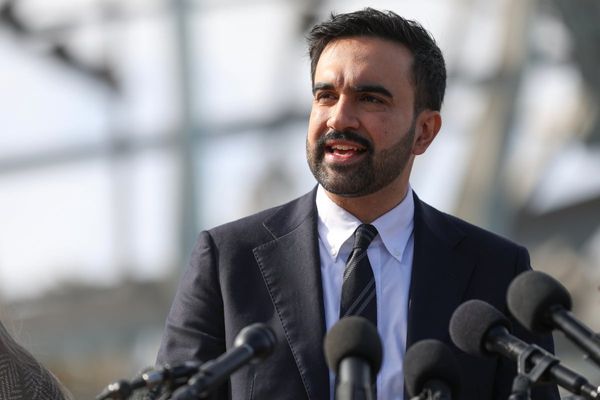
I keep being told that my Tesla will drive itself in the future. That I'll be able to just kick up my feet after a hard day's work while it drives around at night and earns me passive income. It's like taking the worst parts of teleportation and bitcoin mining, throwing it at the wall and hoping it sticks.
But according to Tesla's head of autonomy, that might not be the case anytime soon, because Tesla is still "a couple years" behind Google's Waymo.
Welcome back to Critical Materials, your daily roundup for all things electric and tech in the automotive space. Today, Tesla admits that it's way behind Waymo, Volkswagen electric vehicles will soon reach cost-parity with internal combustion ones, and new vehicle inventory is shrinking thanks to (you guessed it) tariffs. Let's jump in.
30%: Tesla Admits FSD Is 'Lagging By A Couple Years' Behind Waymo
Tesla has always said that it was building the future of autonomy. Yet despite the automaker promising that it will launch its robotaxi service pilot next month (for real this time), that future isn't quite as close as the world might think. And it's already owned by Waymo.
In a rare moment of candor for Tesla, the automaker's Head of Autopilot and AI Software, Ashok Elluswamy, admitted during an interview that Tesla's self-driving tech is still "a couple of years" behind one of the biggest market leaders out there today.
It turns out that Alphabet's Waymo and its fleet of lidar-equipped Jaguar I-Paces is the golden standard of self-driving, but Ashok says that progress isn't what matters most.
"Equal quality," said Ashok when discussing Waymo's self-driving progress compared to Tesla. "Technically, Waymo is already performing. We are lagging by maybe a couple of years."
Now, one could argue what equal quality really means. For example, during a recent test, Business Insider found that Tesla's Full Self-Driving software, which is meant to be supervised by a driver behind the wheel, drove into a bike lane for a few seconds and then ran a red light. Waymo took a different route but didn't experience the same problem. Is that equal quality?
Ashok's argument is that Tesla is getting there. And technically Tesla's fleet is significantly larger and able to collect more data, so it's possible that the automaker could catch up. But by Ashok's own admission, it's not there yet.
Part of the reason Tesla is behind is that the automaker chose to use Tesla Vision, a camera-only approach to autonomy, over Lidar and other sensors. While Waymo was equipping its cars with $75,000 Lidar units, Tesla CEO Elon Musk called the tech a "crutch" and bet all the company's chips on camera sensors that Ashok says can be had for between $1 and $10 per sensor. "The main disadvantage of Lidar is that it's quite expensive," said Ashok. Admittedly, cameras are much more affordable, but lidar has also come down in price to under $1,000 per unit. It's cheap enough for Toyota's $20,000 Chinese-market EV to come with it, so why not Tesla's cars that cost twice as much?
We're missing the point, apparently. Cost also refers to power efficiency. Ashok points out that because cameras are passive and rely on external illumination, they are more efficient. Lidar, on the other hand, works by shooting out beams of light to map out its environment—just don't film it up close with your cell phone, apparently.
Let's look at some real world numbers. The Luminar Halo draws about 10 watts of power. Compared to Tesla's Hardware 4 repeater cameras, which use 0.9 watts per camera (down from 2.2w with HW3), that's definitely a significant reduction—but remember that HW4-equipped cars also come equipped with eight external cameras. So, yes, vision-based systems are more efficient, but there's the argument for efficiency versus accuracy.
The accuracy problem isn't something easy to fix. Maybe that's why Tesla has been promising a fully autonomous coast-to-coast drive since 2016. Solving the problem with vision-only sensors is "technically challenging", according to Ashok. But, he says that it's "more valuable for the world to have a low-cost solution."
It's kind of refreshing to see a Tesla bigwig act a bit human and admit that the company isn't always blazing ahead of every other industry player. It's also kind of shocking, especially as the brand is pushing so hard to show that it's ready to launch a robotaxi service in just a few weeks.
60%: VW's Says Its EVs Will Reach Cost-Parity With ICE Next Year For The First Time Ever

Let's take a moment to forget all about gigacasting, software-defined cars and robotaxi manifestos. Volkswagen thinks that it found the real secret to cheap cars, and it's something so incredibly mundane (yet obvious) that it could save VW's electric butt and actually draw in crowds to dealer lots over the coming years.
Lithium-iron Phosphate (LFP_ batteries aren't particularly sexy. Sure, they're heavier and take up more space, but you're buying into the economical choice here. It's a Timex, not a Rolex. They also may just be the hero that VW needs to reach cost-parity between gas-powered cars and EVs for the first time ever.
Volkswagen recently pulled back the curtain on the upcoming MEB Plus platform. Brand CEO Thomas Schafer spoke about the platform at the Financial Times Future of the Car Congress in London, where he explained how these batteries will be VW's saving grace.
Here's the highlights, courtesy of Automotive News:
The new platform updates the MEB architecture by introducing batteries that use the cheaper lithium iron phosphate (LFP) chemistry, as well as using a less complex cell-to-pack battery layout.
[...]
Reducing battery cost is the “next big step” to achieving profit margin parity with combustion-engine cars, Schaefer told the audience at the Financial Times Future of the Car Congress in London on May 13.
Cell-to-pack simplifies the current battery layout in which cells are arranged into modules and then fit into the pack, reducing the wiring needed and increasing pack density.
Volkswagen CFO Arno Antlitz says that LFP packs will be what power the upcoming Volkswagen ID.2 (no, that's not its final name). And thanks to LFPs contributing to a massive reduction in production cost, the ID.2 will officially be the first Volkswagen EV to match the profit margins of a gas-powered car in its lineup, the T-Cross.
Of course, VW warns that the cost to build cells is greatly affected by the cost of electricity. Schafer warns that for every cent above the target price of $0.06 per kilowatt-hour, Volkswagen's costs increase by nearly $114 million. Meaning, electricity costs of $0.12 per kWh could mean shelling out an extra $684 million to produce the same number of otherwise identical cells.
These "Unified Cell" batteries will be built by VW's own startup, PowerCo, across three plants in Germany, Canada and Spain. Production is slated to start towards the end of 2025 at the factory in Salzgitter, Germany.
Make no mistake: this is huge news. Cost parity between ICE and EV has been a long time coming. The culprit of the disproportionate EV cost? Batteries. It's always been batteries. They're expensive, after all.
Reducing the cost and complexity so astronomically that it finally reaches a critical tipping point is a huge win for VW—and, let's face it, for car buyers everywhere.
90%: New Vehicle Inventory Is Shrinking And Prices Are Going Up

If you've been thinking about buying a new car, now might be the time to panic shop. Dealer lots are getting emptier by the day, and (unsurprisingly) tariffs are to blame.
The data comes from Cox Automotive, which shows a drop in inventory of 10.5% year-over-year and a 7.4% slide since March.
According to Cox Automotive, U.S. new vehicle inventory dropped in April, the first significant dip in more than a year, apparently. We're down to around 2.49 million cars on lots, which is around 66 days of supply. That might seem like a lot—heck, that supply is enough to sell 37,000 cars every single day across 262 million Americans who are over 18—but it's not the quantity that matters, it's the direction.
Cox Automotive explains:
May opened with a total supply of new vehicles on dealer lots across the U.S. at 2.49 million units, down 7.4% from the 2.69 million units at the start of April and down 10.5% from a year ago. Seasonal patterns persist, as it is not unusual to see sales rise during the traditional “spring bounce.” Inventory, however, is not being replenished at the same rate. Some automakers are likely holding the line on deliveries and production, as everyone struggles with the uncertainty surrounding the administration’s tariff policies.
Cox Automotive’s vAuto Live Market View days’ supply is based on the estimated retail sales pace for the most recent 30-day period. New-vehicle days’ supply, at the start of May, was 66, down 16 days compared to last year and down six days from last month. As automakers prepare to bring 2026 model year vehicles to showrooms and introduce post-tariff-announcement pricing, inventory is expected to rise, but higher prices may further slow the pace of sales.
The sore thumb here is what Cox called the "spring bounce." Sales are usually up in the spring, but that also comes with the usual replenishment of inventory. Unfortunately, what dealers are experiencing is a lower inventory because some OEMs are manufacturing at a lower rate than usual, thanks to tariff uncertainty.
And what does this mean for the consumer? Fewer choices, less incentives and (as the data shows) inflated prices.
As inventory begins to dwindle, buyers are pushed towards trims with higher-margin, higher-cost trims. In fact, the overall Average Transaction Price of a new car hit $48,699 (up 1.1% YOY) while the ATP of an EV rose to $59,225 (3.7% higher YOY and up from $55,000 in January).
The actual long-term impact of tariffs is a very big unknown at this point. Many automakers are raising prices in anticipation of no longer being able to absorb the full cost of Trump's protectionism. This could deter buyers from picking up a new car, but if buyer demand holds steady instead, new car inventory might begin to dip to levels not seen since the chip shortage drove down inventory following Covid. It could also drive up used car prices should selection continue to fall or prices rise to unsustainable levels.
100%: Would You Trade Range For Dollars?

VW's push for cheaper, LFP-equipped cars has me thinking about range. DC fast charging is getting pretty good across more and more of the U.S. I (thankfully) haven't been in a situation where I've been unable to reach a charger in my EVs, though I've gotten close in the past.
I feel like the "magic number" for range is around 250 miles for most people today. It's not a lot, but it's enough for most suburban-dwelling Americans who aren't commuting long distances, road-tripping or towing frequently. But for others, that range might not be even close to enough once you factor in climate, driving habits and highway driving.
Now here's my question: how much is range worth to you?
That's a broad question, I know, but how much money a range slash would you be willing to put up with for a steep discount? Or, inversely, how much extra would you pay for more miles per charge? Let me know your thoughts in the comments.







